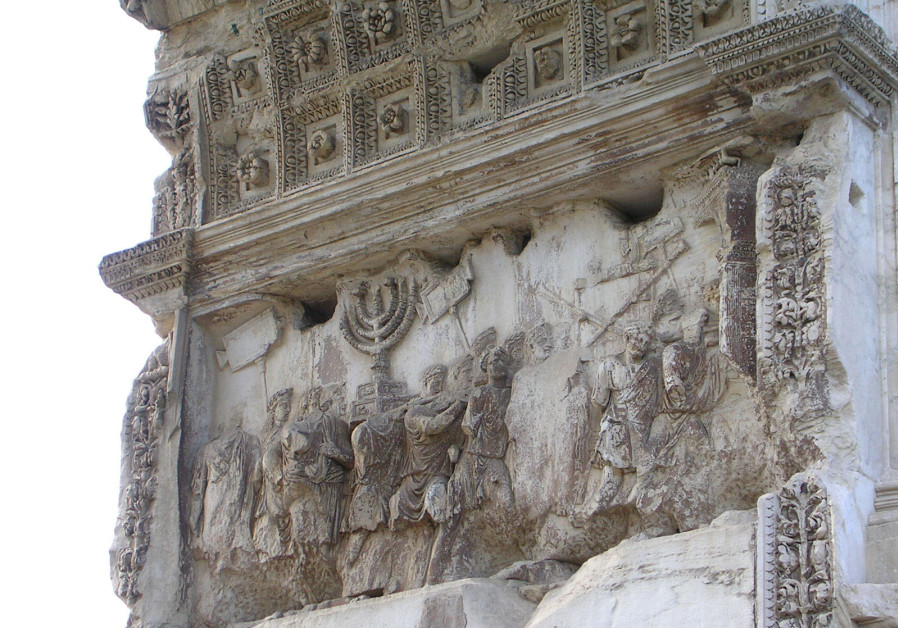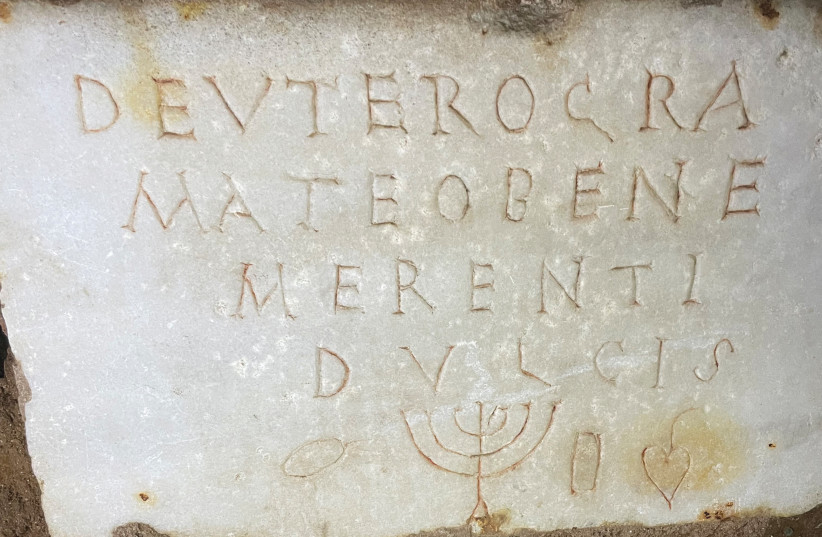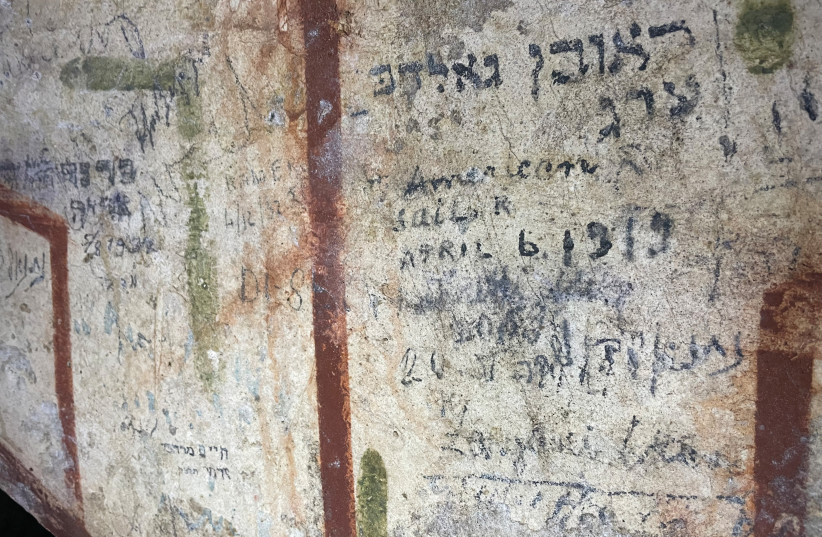
Shortly before Purim this year, I fulfilled a dream of at least a decade – touring one of the Jewish catacombs of Rome.
This off-the-beaten-track experience is not for everyone – especially religiously observant cohanim (priests), children or people with mobility issues – but for me, it was a memorable and fascinating visit.
I was traveling with my two adult sons, and we had all been to Rome before. Our trip included Sicily, Naples and Pompeii, and we wanted to spend Shabbat somewhere where we could attend synagogue services and replenish our food supply. Rome was the obvious choice. We had already seen most of the wonderful, well-known sites that make Rome such an amazing city. Touring the Jewish catacombs would make the trip memorable and significant, especially since on my previous trip, they were closed due to flooding.
A web search yielded information about the opening of the Vigna Randanini (Randanini’s Vineyard) catacombs along the Appian Way, a short cab ride from Rome’s center. I reserved a private tour (public tours are occasionally available, but not on the Friday we planned to spend in Rome) with the extremely knowledgeable and captivating tour guide, Marco Misano, of romanjews.com.
These particular catacombs were discovered in 1859 on private land, and date from the early centuries of the Common Era. The Jews interred there (and in other catacombs in Rome) most likely arrived in Rome after the Destruction of the Second Temple in 70 CE, when tens of thousands were brought there as slaves from Judea. Some archeologists date the catacombs a century or two later – which would make those interred the descendants of the Jews exiled to Rome following the Destruction.

The history of Jews in Rome dates back even further. About a century and a half earlier, the Hasmonean kingdom in the Land of Israel sent ambassadors to Imperial Rome. When the Judean exiles arrived after the destruction of Jerusalem, they found a Jewish community already functioning there.
There are remnants of a synagogue in the Ostia Antica port town, Rome’s closest access to the Mediterranean. Ask any Roman Jews when their family arrived in that city and they will proudly tell you. Today, the community is made up of Jews who arrived in the 1970s from Libya (a rescue operation on the part of the Italian government), descendants of Jews expelled from Spain in 1492, and others who moved to the capital city from smaller cities within Italy, in addition to the original Roman Jewish population.
ROMAN JEWS do not consider the Jewish catacombs in their city as archaeological sites; to them, these are the graves of their ancestors, which they regard with great reverence. Hence, it was surprising for me to see exposed remains in a number of the burial niches, which had once been covered by plaster, marble tablets, or both. In the catacombs of Villa Torlonia, at the direction of the Italian chief rabbinate, the human remains were moved to a specific area which was subsequently walled up.
The Roman conquest of Judea and the sacking of the Temple was celebrated by Vespasian and his son Titus by the construction of the famous arch of Titus and the Colosseum – the latter financed by the booty brought back from Jerusalem.
The famous depiction of the seven-branched menorah carried in triumph on the Arch of Titus shows a massive hexagonal base, decorated with obviously pagan motifs. Israel’s late Chief Rabbi Isaac Herzog noted that, according to Jewish tradition, the menorah rested on a tripod. He posited that the original base was broken and replaced with another one by the Romans. Some scholars suggest that the image of the menorah on the Arch of Titus was copied from a candelabra found in a pagan temple. The branches of the menorah in the catacombs are curved – unlike the straight branches portrayed by Maimonides in the margin of his work, Mishneh Torah.
The menorah figures prominently among the Jewish symbols (lulav and etrog, Torah scrolls, etc.) engraved on the tombstones and walls of the catacombs. It rests on a tripod and the branches are curved – like similar depictions from the same period in Israel.
It is very likely that the Jew who carved the menorah in the catacombs of Vigna Randanini was forcibly brought to Rome by his captors and had actually seen the menorah – possibly in the Temple in Jerusalem.
This possibility was especially moving for my sons and myself. It was hard to evade the symbolism of traveling to Rome on Israeli passports bearing the national emblem of the menorah to see a depiction of the original carved by Jews to express their longings for Jerusalem.
WE SAW frescoes of palm trees, a common Judean motif, on the walls of the catacomb. At the end of our tour, Marco gave us a small gift: a medallion that bore the image of a triumphant Roman soldier standing next to a palm tree with a mourning Jewish woman seated beneath with the legend “Judea Capta” (Judea Conquered), a facsimile of a coin minted by the Romans. The obverse showed a palm tree flanked by an Israeli woman lifting a baby in the air on one side and a man wearing a kova tembel planting a sapling. That side bore the legend “Israel Liberated – 1948.”
Many of the marble tablets that once covered the burial niches were plundered over the years; many of them are said to have found their way to the Jewish Lapidarium in the Vatican Museums and other collections. It is interesting to note the nearly complete absence of Hebrew inscriptions – the overwhelming majority are in Latin and some are in Greek. Nevertheless, the Jewish symbols and phrases which Marco translated for us such as “lover of the law” and “scribe” indicated that these were Jews buried here. One tombstone indicated that the departed was a mohel, a ritual circumciser. The engraving looked like a knife to me, although Marco gave it a different, more graphic interpretation, and my sons sided with his view.
In general, the state of the catacombs is quite deteriorated. Even before their discovery in 1859, antiquities were plundered from the site. There are recesses in the walls that once held oil lamps, but none are present on the site. We needed to use our cell phone flashlights, since the site was in utter darkness.
THE GUARD who opened the catacombs for us was the scion of a noble Roman family, a descendant of the Principi del Gallo di Roccagiovine, who purchased the property in the early 20th century from the Randanini family. The guard’s father had built numerous supporting walls to avoid internal collapse, and he has continued this project. A well was recently discovered in a fairly open area, which indicates that ritual washing of the dead took place there.
We visited one room of the complex which had been defaced by graffiti from the first half of the last century. There we saw inscriptions in a number of languages, including Hebrew, Yiddish and English, attesting to visitors from Tel Aviv, Cleveland and Shavli, Lithuania.

Marco’s tour was enlightening and fascinating. His studies in archeology, history and in the Rome Yeshiva, as well as his passion for Jewish heritage, were at the forefront of his lucid explanations.
His personal story was moving as well: as a child he was in the Great Synagogue of Rome when Palestinian terrorists attacked on Shabbat morning, October 9, 1982. Two-year-old toddler Stefano Gaj Taché was killed in the attack, and 37 other worshippers were injured. This harrowing experience left young Marco with a stutter. But since he learned English and Hebrew only after this traumatic event, he speaks both of these languages fluently without any trace of a speech impediment. He looked for a career in a profession in which he could use his linguistic facility, and found one in guiding tourists.
AFTER THE silence of the catacombs, the bustle of Erev Shabbat in the Jewish Ghetto of Rome was especially pronounced. The Jewish school had just been let out, and many parents were there to collect their children. The kosher restaurants were full to overflowing, with standing-room only at Bona Pizza where one can buy rectangular slices of pizza with various toppings by weight (although this branch of Bona Pizza is certified kosher by the Rome rabbinate, other locations are not). From there, we proceeded to La Cremeria Romana for delicious gelato.
A long line snaked from the Boccione Bakery, operated by the Limentani family for nearly 200 years. While waiting on line, I was able to consult with two women about which pastries would remain reasonably fresh until Purim. The overwhelming consensus was biscottini – toasted mocha flavored almond biscotti. Nevertheless, I couldn’t pass up the famed pizza ebraica – not what you would call a pizza at all, but a small yeast cake filled with candied fruit and almonds. I doubt if they would have remained fresh for the days until Purim, but in any case they were devoured on Shabbat. It is said that the pizza ebraica originated in Sicily (at that time under Spanish rule) and was brought to Rome by Jews expelled from that island in 1492.
A number of the kosher restaurants in the ghetto offer Shabbat meals, as does Chabad of Trastevere. I consulted Marco and he suggested that I contact Elisabetta Piazza (kosherlisa@gmail.com) who provided us with sumptuous meals for Shabbat as well as a warming tray to heat them up. Her catering is under the supervision of Rabbi Hazan of Rome Habad. She sent me a menu from which I could order in advance. There was so much food (including the customary Italian first course of pasta!) that we had enough to take with us to our next destination, Naples.
ATTENDING PRAYER services at the Tempio Maggiore (Great Synagogue) is a special experience. The structure, with its singular rectangular dome, stands out in Rome’s skyline. The vast interior of this majestic synagogue is equally impressive. The acoustics are not the best, and it may be difficult for visitors to follow the service. The rite (nusah) is unique to Roman Jewry, being neither Sephardi nor Ashkenazi. Jerusalem’s Italian synagogue on Shammai Street follows the same tradition.
On Shabbat morning we attended services with the more intimate Sephardic minyan that takes place in the bottom floor of the synagogue, near the Judaica museum entrance. The atmosphere was friendly and there was a sense of community. The young rabbi spoke, expressing profound and erudite ideas in fairly simple language, communicating well with his congregation. A delicious kiddush was served in celebration of the birthday of one of the congregants, a dapper 90-year-old gentleman. We were pleased to meet Marco there.
In order to attend Shabbat services it is essential to contact the Rome rabbinate ufficio.rabbinico@romaebraica.it and send a photo of your passport and COVID vaccination certificate in advance – by Thursday. When we arrived at the synagogue on Friday evening, we saw aggravated people who were obliged to at least begin their prayers on the sidewalk. Security and safety are prime concerns, and the guards are very strict. When we visited, the rules regarding the wearing of masks (N95) were rigorously enforced on airplanes, museums – and in the synagogue. Check online to see if these regulations have changed in Italy.
After Shabbat we enjoyed an amazing meal at the Yotvata dairy restaurant. We feasted on fried artichoke (the quintessential Roman Jewish delicacy), gnocchi, ravioli – and of course, pizza. When the proprietor came by to say “shalom,” I mentioned that I had been in the Sephardic service where he had received the honor of reciting the haftarah (reading from the prophetic books). He asked me if he read well, and I replied that he read very well, which made me realize that the prophet Samuel, Agag the Amalekite king and King Saul all spoke Hebrew with an Italian accent.
After our more than ample meal we took a long walk to see some of Rome’s breathtaking sights by night: Piazza Navona, Trevi Fountain, the Colosseum and the Arch of Titus. We left Rome the following morning, still under the spell of that enchanted city. ■







